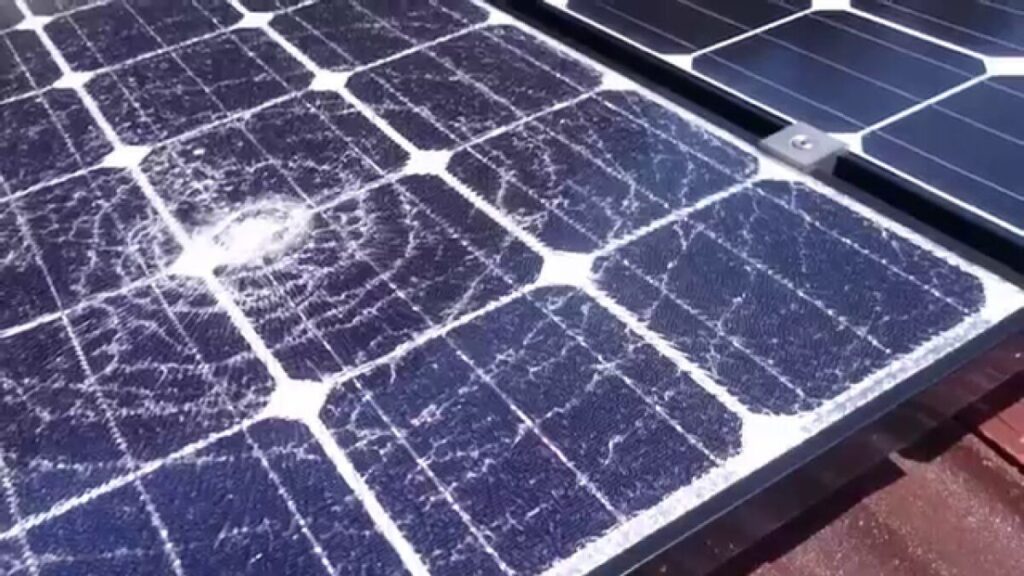The National Renewable Energy Laboratory noted an increase in spontaneous glass breakage in solar panels. The Renewable Energy Test Center’s PV Module Index examines these and other glass-related trends in solar energy production.
Glass is a unique material used for its chemical stability and visual transparency. It is often used in solar panels as a protective outer layer.
In his annual Index of PV modulesthe Renewable Energy Test Center (RETC) examined emerging issues in solar glass production and field performance. Reports were found of a worrying increase in solar panel glass breaking spontaneously in the field, sometimes even before commissioning.
Teresa Barnes, Ph.D., manages the Photovoltaic Reliability and System Performance Group at the National Renewable Energy Laboratory (NREL). Barnes and her colleagues at NREL reported the problem.
“Spontaneous glass breakage is an example of a failure mode that we have not seen before. When I first started working on solar panel reliability seven or eight years ago, the most we heard about glass breakage was sloppy operation and maintenance practices,” Barnes said.
Now this is no longer the case and the NREL reliability team regularly receives reports of glass breakage in silicon modules that are not related to direct damage due to maintenance or storm impacts. The team found that the average quality of solar glass appears to decline over time.
“It used to be the case that modules would pass the IEC 61215 static load test with a large safety factor,” Barnes said. “Today, modules barely pass the basic static load test or fail with higher safety factors. Some new module designs simply do not pass the minimum static load test.”
The NREL team is beginning to hypothesize that glass damage in solar panels undergoes a similar process as a car windshield that needs to be replaced. When a windshield sustains damage, it is often only visible as a small star-shaped mark that appears insignificant. But when extreme weather conditions with very high or low temperatures occur, the severity of the damage becomes fully apparent and a large crack suddenly appears over the entire surface.
“We think a similar dynamic could be the cause of spontaneous solar glass breakage,” says Barnes.
This increase in breakage is likely due to the trend of solar glass becoming thinner over time, according to NREL. Central Tension’s Mike Pilliod, speaking at NREL’s 2024 PV Module Reliability Workshop, said any manufacturer can temper 3mm glass. But below 3 mm, tempering glass is a difficult process. He said that as glass becomes thinner, fewer defects are needed to create strength-limiting flaws in the glass. These shortcomings are being actively studied by NREL to understand some of the potential pitfalls of using thin glass in solar energy production.
Barnes warned that it may be a combination of effects that makes glass breakage a greater threat than before. Modules are getting bigger, frames are getting thinner and mounting rails are getting closer together. All these factors lead to “large, flimsy modules” that exert more pressure on the glass surface, which also becomes thinner in many modules.
The NREL team said at this year’s PV Module Reliability Workshop that manufacturers were starting to talk about introducing thicker frames and wider mounting positions.
“As people better understand how the module system works together, they can work to optimize the way loads are balanced,” Barnes said. “The pendulum in that balancing act may already be swinging back toward the integrity of the frame and mounting rail.”
While some module providers focus on frames and mounting, others have introduced tempered glass modules that are marketed as hail-hard and resistant to extreme weather.
RETC asked Barnes about the recent catastrophic losses in Texas, where hailstorms caused hundreds of millions of dollars in damage to operational solar facilities.
GCUBE Insurance, a renewable energy insurer, said despite accounting for only 1.4% of total insurance claims filed, approximately 54% of the incurred costs of total solar losses can be attributed to hail. This is based on data that Gcube has collected over the past five years. The average cost was $58 million per claim.
“Ten years ago, people would chase you out of meetings if you talked about climate-specific module designs. The consensus was that this would simply be too expensive,” Barnes said. “Now climate-specific modules and climate-specific testing are starting to look feasible as we see more emphasis on total system costs. It is entirely possible that we see hail-hardened modules, especially in a market like the United States, where it could be worth paying more up front for hail resistance.”
This content is copyrighted and may not be reused. If you would like to collaborate with us and reuse some of our content, please contact: editors@pv-magazine.com.

